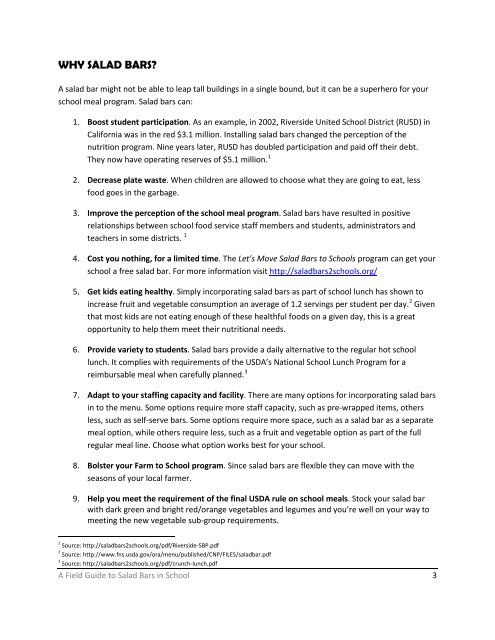A Field Guide To Salad Bars In Schools - Minnesota Department of ...
A Field Guide To Salad Bars In Schools - Minnesota Department of ...
A Field Guide To Salad Bars In Schools - Minnesota Department of ...
You also want an ePaper? Increase the reach of your titles
YUMPU automatically turns print PDFs into web optimized ePapers that Google loves.
WHY SALAD BARS?<br />
A salad bar might not be able to leap tall buildings in a single bound, but it can be a superhero for your<br />
school meal program. <strong>Salad</strong> bars can:<br />
1. Boost student participation. As an example, in 2002, Riverside United School District (RUSD) in<br />
California was in the red $3.1 million. <strong>In</strong>stalling salad bars changed the perception <strong>of</strong> the<br />
nutrition program. Nine years later, RUSD has doubled participation and paid <strong>of</strong>f their debt.<br />
They now have operating reserves <strong>of</strong> $5.1 million. 1<br />
2. Decrease plate waste. When children are allowed to choose what they are going to eat, less<br />
food goes in the garbage.<br />
3. Improve the perception <strong>of</strong> the school meal program. <strong>Salad</strong> bars have resulted in positive<br />
relationships between school food service staff members and students, administrators and<br />
teachers in some districts. 1<br />
4. Cost you nothing, for a limited time. The Let’s Move <strong>Salad</strong> <strong>Bars</strong> to <strong>Schools</strong> program can get your<br />
school a free salad bar. For more information visit http://saladbars2schools.org/<br />
5. Get kids eating healthy. Simply incorporating salad bars as part <strong>of</strong> school lunch has shown to<br />
increase fruit and vegetable consumption an average <strong>of</strong> 1.2 servings per student per day. 2 Given<br />
that most kids are not eating enough <strong>of</strong> these healthful foods on a given day, this is a great<br />
opportunity to help them meet their nutritional needs.<br />
6. Provide variety to students. <strong>Salad</strong> bars provide a daily alternative to the regular hot school<br />
lunch. It complies with requirements <strong>of</strong> the USDA’s National School Lunch Program for a<br />
reimbursable meal when carefully planned. 3<br />
7. Adapt to your staffing capacity and facility. There are many options for incorporating salad bars<br />
in to the menu. Some options require more staff capacity, such as pre-wrapped items, others<br />
less, such as self-serve bars. Some options require more space, such as a salad bar as a separate<br />
meal option, while others require less, such as a fruit and vegetable option as part <strong>of</strong> the full<br />
regular meal line. Choose what option works best for your school.<br />
8. Bolster your Farm to School program. Since salad bars are flexible they can move with the<br />
seasons <strong>of</strong> your local farmer.<br />
9. Help you meet the requirement <strong>of</strong> the final USDA rule on school meals. Stock your salad bar<br />
with dark green and bright red/orange vegetables and legumes and you’re well on your way to<br />
meeting the new vegetable sub-group requirements.<br />
1 Source: http://saladbars2schools.org/pdf/Riverside-SBP.pdf<br />
2 Source: http://www.fns.usda.gov/ora/menu/published/CNP/FILES/saladbar.pdf<br />
3 Source: http://saladbars2schools.org/pdf/crunch-lunch.pdf<br />
A <strong>Field</strong> <strong>Guide</strong> to <strong>Salad</strong> <strong>Bars</strong> in School 3
















